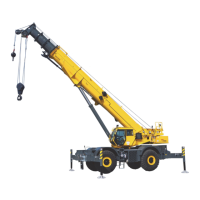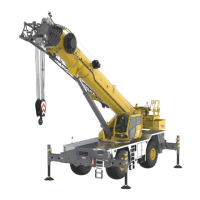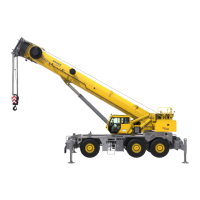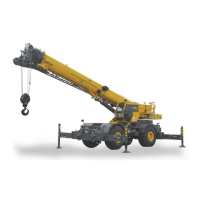Grove Published 3-25-2020, Control # 595-10 3-69
GRT8100 OPERATOR MANUAL OPERATING CONTROLS AND PROCEDURES
1. Stop crane by pressing Service Brake Foot Pedal.
2. Position Transmission Shift Lever to neutral (N) position.
3. Position Drive Axle Selector Switch to four-wheel low.
NOTE: If Drive Axle Selector Switch is positioned to
four-wheel low, Service Brake Foot Pedal is not
pressed, and Transmission Shift Lever is not in
neutral (N) position Four-Wheel Drive Indicator will
flash and four-wheel drive function will not engage.
4. Select gear speed and direction of travel with Transmission
Shift Lever and Knob.
5. Drive crane following Traveling — Forward, page 3-67.
6. Return Drive Axle Selector Switch to two-wheel high
position as soon as two-wheel traction will suffice and
crane motion has stopped. Service Brake Foot Pedal
must be pressed and Transmission Shift Lever must be
in Neutral (N) position to shift from four-wheel low to
two-wheel high.
Differential Lock Operation (Optional)
NOTE: Differential lock will not operate unless Drive
Selector Switch is in four-wheel low position.
General
The purpose of the differential lock is to provide maximum
traction and control on poor road or highway surfaces. When
differential locks are actuated, the clutch collar completely
locks the differential case, gearing, and axle shafts together,
maximizing traction to both wheels of each axle. The lock
position will also protect against spinout.
When normal driving conditions exist (during periods of good
traction), differential locks should not be actuated. Axles
should be allowed to operate with differential action between
both wheels.
Follow steps below when engaging/disengaging the
differential lock function.
1. Lock differentials by pressing and holding the Axle
Differential Control Switch in the lock position.
Disengage the function by releasing the switch.
2. Lock/unlock differentials only when vehicle is standing
still or moving at a constant low speed with wheels not
slipping.
3. Locked differentials cause crane’s turning radius to
increase, creating an understeer condition. Use caution,
good judgment, and drive at low speeds when operating
vehicle with locked differentials.
4. Lock differentials only when maximum traction is
needed on poor road or highway surfaces.
5. Always unlock differentials when need for maximum
traction has passed or when traveling on good road or
highway surfaces.
Operation
The differential lock function should preferably be engaged
when crane is stationary but may be engaged when moving,
if the following conditions are met:
1. Crane is moving very slowly (creep speed).
2. Wheels are not spinning at time of engagement.
When traveling with differentials locked, do not deviate from
a straight path more than absolutely necessary. Engage
differential locks by doing the following:
1. Position Axle Differential Lock Control Switch to the
locked position with crane stationary or moving at a slow
speed.
If moving at a slow speed, let up momentarily on the
Foot Throttle Pedal to relieve torque on the differential
gearing. This will fully engage differential locks.
NOTE: When differentials are locked, Axle Differential
Locked Indicator illuminates.
2. Proceed over poor road condition cautiously.
CAUTION
Unexpected Operation!
When using differential lock, steering characteristics may
be affected.
Try to use four-wheel drive to gain adequate traction
before using differential lock.
Do not operate differential lock when traveling downhill; at
speeds above 16.1 km/h (10 mph); on hard, dry surfaces;
and/or during axle spin-out.
CAUTION
Possible Machine Damage!
When driving on hard, dry surfaces with differentials
locked, do not turn the wheels. Damage to drive line
components can result.
Do not lock differentials when wheels are slipping.
Damage to differentials can result.
CAUTION
Possible Loss of Vehicle Stability!
Do not lock differentials when vehicle is traveling down
steep grades and traction is minimal.

